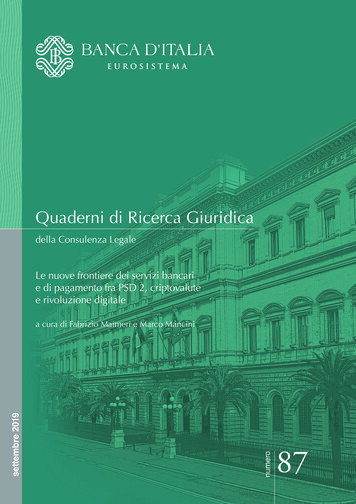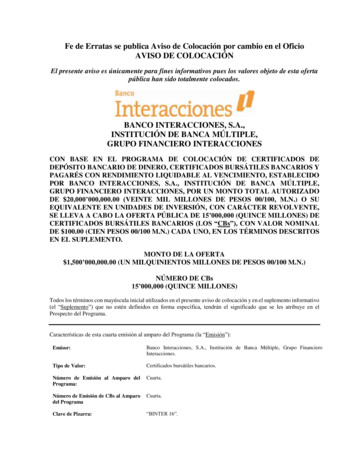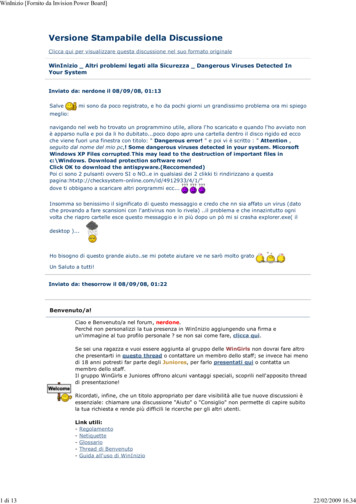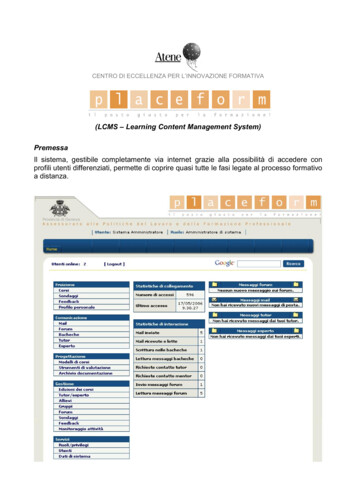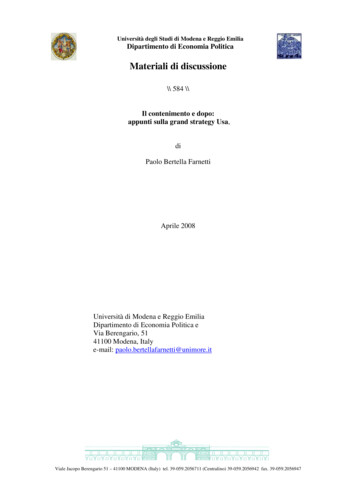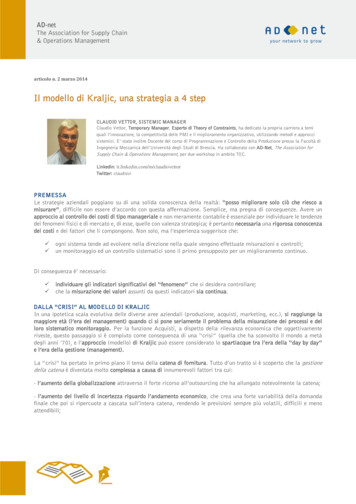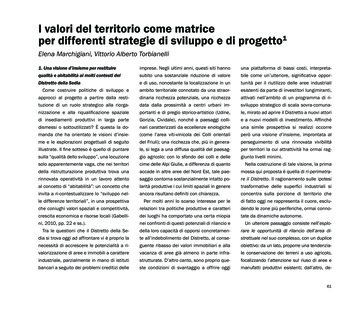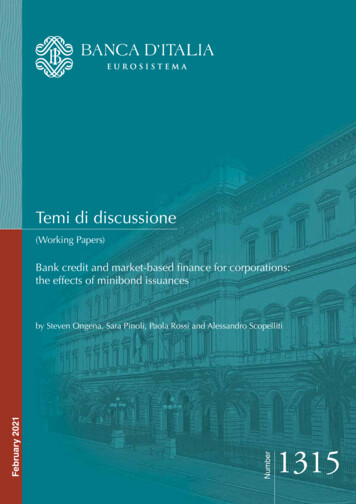
Transcription
Temi di discussione(Working Papers)Bank credit and market-based finance for corporations:the effects of minibond issuancesNumberFebruary 2021by Steven Ongena, Sara Pinoli, Paola Rossi and Alessandro Scopelliti1315
Temi di discussione(Working Papers)Bank credit and market-based finance for corporations:the effects of minibond issuancesby Steven Ongena, Sara Pinoli, Paola Rossi and Alessandro ScopellitiNumber 1315 - February 2021
The papers published in the Temi di discussione series describe preliminary results andare made available to the public to encourage discussion and elicit comments.The views expressed in the articles are those of the authors and do not involve theresponsibility of the Bank.Editorial Board: Federico Cingano, Marianna Riggi, Monica Andini, AudingaBaltrunaite, Marco Bottone, Davide Delle Monache, Sara Formai, FrancescoFranceschi, Adriana Grasso, Salvatore Lo Bello, Juho Taneli Makinen, LucaMetelli, Marco Savegnago.Editorial Assistants: Alessandra Giammarco, Roberto Marano.ISSN 1594-7939 (print)ISSN 2281-3950 (online)Printed by the Printing and Publishing Division of the Bank of Italy
BANK CREDIT AND MARKET-BASED FINANCE FOR CORPORATIONS:THE EFFECTS OF MINIBOND ISSUANCESby Steven Ongena*†, Sara Pinoli‡, Paola Rossi‡ and Alessandro Scopelliti§*AbstractWe study the effects of diversifying funding sources on the financing conditions forfirms. We exploit a regulatory reform that took place in Italy in 2012, i.e. the introduction of‘minibonds’, which opened a new market-based funding opportunity for unlisted firms. Usingthe Italian Credit Register, we investigate the impact of minibond issuance on bank creditconditions for issuer firms, both at the firm-bank and firm level. We compare new loansgranted to issuer firms with new loans concurrently granted to similar non-issuer firms. Wefind that issuer firms obtain lower interest rates on bank loans of the same maturity than nonissuer firms do, suggesting an improvement in their bargaining power with banks. In addition,issuer firms reduce the amount of used bank credit but increase the overall amount ofavailable external funds, pointing to a substitution with bank credit and to a diversification ofcorporate funding sources. Studying their ex-post performance, we find that issuer firmsexpand their total assets and fixed assets, and also raise their leverage.JEL Classification: G21, G23, G32, G38.Keywords: bank credit, capital markets, minibonds, loan pricing, SME finance.DOI: 10.32057/0.TD.2021.1315Contents1. Introduction . 52. Firm capital structure: bank credit and capital markets. 93. Institutional background and stylized facts . 124. Empirical analysis . 155. Firm-bank level analysis. 246. Firm level analysis . 287. Robustness checks . 338. Conclusions . 35References . 38Figures and tables . 42Appendix A. Regressions based on the propensity score matching . 61Appendix B . 64*University of Zurich.†Swiss Finance Institute, KU Leuven and CEPR.‡Bank of Italy, Economic Research Division, Milan.§European Central Bank, DG-Monetary Policy.
1.Introduction 1The integration between bank credit and market-based finance for corporations is at the center ofthe current policy debate on the Capital Markets Union in Europe, due to the strong dependence of firmsand particularly SMEs on bank credit for their funding needs. This long-standing feature has becomeeven more topical in the discussion on the alternatives to bank credit in the recovery from the Covid-19crisis (Financial Times, 2020).Indeed, the shock of the pandemic has put additional pressures on existing vulnerabilities ofEuropean banks, and raised some new challenges. Even if the strong response of policy authorities hasprovided decisive support to bank credit to firms at the peak of the crisis, 2 the weaknesses of the bankingsector accentuated by the shock may hinder its future ability to finance the recovery. In this perspective,easing access to market-based financing sources may reduce firms’ overly reliance on bank financing,support their investments and then contribute to economic growth. This strengthens the view thatrenewed policy commitments to promote the Capital Markets Union are needed now more than ever, indealing with the challenges of the post-pandemic recovery (De Guindos, Panetta and Schnabel, 2020;High-Level Forum on the Capital Markets Union, 2020; Wieser, 2020).In previous years, given the strong legacies of the global financial crisis and the sovereign debtcrisis for the European banking system, policy authorities had considered various initiatives to extendthe range of funding sources for SMEs, including the removal of existing regulatory obstacles to the useof market-based funding. However, progress has been so far limited in the development of the agendaThe authors wish to thank Carlo Altavilla, Thorsten Beck, Marina Brogi, Claire Célérier (discussant),Olivier Darmouni, Carmine Di Noia, Annalisa Ferrando, Paolo Finaldi Russo, Xavier Freixas, MariassuntaGiannetti, Christoph Herpfer, Guillaume Horny (discussant), Victoria Ivashina, Angela Maddaloni, FrancescoManaresi, Valentina Michelangeli (discussant), Melina Papoutsi (discussant), Fabio Parlapiano, Francesco Saita,Fabiano Schivardi, Andrea Sironi, Boris Vallée, Zhang Xiang (discussant) and the participants at a workshop heldat the Bank of Italy (Rome, December 2018), the Conference “Securities Markets. Trends, Risks and Policies”(Bocconi University, Milan, March 2019), the 2019 Swiss Winter Conference on Financial Intermediation(Lenzerheide, April 2019), the 4th ENTFIN Conference on Entrepreneurial Finance (Trier, July 2019), theConference on “Regulating Financial Markets” (Goethe University, Frankfurt, August 2019), the Third AnnualWorkshop of the ESCB Research Cluster 3 on “Financial Stability, Macroprudential Regulation andMicroprudential Supervision” (Banco de España, Madrid, October 2019), the 2020 European EconomicAssociation Conference (online, August 2020), a seminar at the European Central Bank (Frankfurt, October 2020),and the 2021 American Finance Association Annual Meeting (virtual, January 2021) for their insightful comments.Ongena and Scopelliti acknowledge financial support from ERC ADG 2016 - GA 740272 lending.The views presented in this paper are those of the authors and should not be attributed to Banca d’Italia,the European Central Bank or the Eurosystem.1For a recent study on the effects of the monetary, micro- and macroprudential policy measures adoptedduring the pandemic on bank lending conditions, see Altavilla, Barbiero, Boucinha and Burlon (2020).25
for establishing the Capital Markets Union (Bhatia et al., 2019; Constâncio et al., 2019). Now, in lightof the fallout from the Covid-19 crisis and of the new financing needs for firms, it is important to assessthe effects of some policy initiatives developed in the area of capital markets in recent years, to drawrelevant implications for the forthcoming policy design at the European level.In this paper, we investigate the impact of the diversification of funding sources – following theissuance of corporate bonds – on the financing conditions of issuer firms with a particular focus on theirlending relationships with banks. This is particularly relevant for SMEs, as these firms – also in the caseof bond issuance – may still rely to a significant extent on bank credit due to the potential benefits oflending relationships. Banks are able to gather soft information about firms and to perform monitoringactivity, thus reducing agency costs and providing effective incentives to firms in favor of high-qualityinvestments (Diamond, 1984; Rajan, 1992). The flip side of the coin is that the incumbent banks canextract some monopoly rents due to their informational advantage (hold-up effect; Sharpe, 1990; VonThadden, 2004) and, consequently, strong dependence on bank credit may lead to an increase infinancing costs.It is therefore crucial to explore whether the diversification of funding sources through capitalmarkets allows issuer firms to improve their bargaining power with banks in setting the credit conditions,and to examine to what extent the ability to issue corporate bonds affects their debt structure. Suchempirical analysis presents two main challenges: first, we need to identify an exogenous event enactingthe ability of firms to get capital markets funding, such that firms previously unable to issue corporatebonds would then be allowed to do it; second, for a given sample of issuer firms (treated) we have toconstruct a counterfactual sample of non-issuer firms (control) with ex-ante comparable financialcharacteristics.The introduction of a recent regulatory reform in Italy provides an interesting experiment to studythe ex-post consequences of bond issuance on corporate credit conditions, within an empirical settinguseful to deal with the above challenges. In 2012 a reform aimed at improving the access to capitalmarkets by small and medium enterprises was introduced by the Italian Government. It removed thepre-existing limits to the issuance of corporate bonds by unlisted firms, provided that the securities werenegotiated in a regulated market or in a multilateral trading facility. It also extended to these bonds thefavorable tax treatment established for the bonds issued by listed firms. Since the new bond issues wereexpected to be of limited amounts, they were called “minibonds”.We exploit this regulatory shock in order to investigate the ex-post impact of the issuance ofminibonds on the financing conditions of Italian corporations, both at the firm-bank level and at the firm6
level. We explore how the recourse to capital markets may have ex-post changed the credit conditionspracticed by banks to the issuer firms and the performance of issuer firms.We study the effects of the switching behavior of firms from bank credit to debt funding, byextending the empirical framework developed by Ioannidou and Ongena (2010) to the issuance of debtinstruments. In particular, we analyze whether corporate issuers were able to obtain lower lending ratesfrom banks after the minibond issuance, compared to ex-ante similar non-issuer firms. On one hand, thediversification of funding sources may improve the bargaining power of firms in the lendingrelationship, so it could eventually lead to an improvement of loan conditions for firms. On the otherhand, if the market rates required by investors are still higher than the bank rates, as for the first issuancesof minibonds, credit institutions may have relatively less incentive to ease the lending conditions forcorporations.We consider the issuances of minibonds starting from the fourth quarter of 2012 to the end of2016 and we focus on the first issuance for each firm, as this will provide the first clear message that thefirm is able to get funding directly from capital markets. Since the loan offer to a treated firm in the caseof non-issuance would not be observable, we match the new loans granted to issuer firms with the newloans granted at the same time to non-issuer firms that have similar pre-determined characteristics. Tobuild the counterfactual sample of non-issuer firms, the existing literature suggests that firm levelcharacteristics – such as credit ratings, net worth, investment opportunities – may play some role in thefirms’ choice between bank loans and market debt. We allow the selection of issuer versus non-issuerfirms to be driven by firms’ characteristics rather than by a purely random assignment. This is indeedrelevant for the design of our empirical methodology. To deal with these pre-existing differences andreduce the possible endogeneity of the treatment, we implement an exact matching technique on a wideset of ex-ante firms’ characteristics and balance sheet performance in order to identify comparable nonissuer firms. We are able to match 92 issuer firms with around 2,700 control firms.The data combine information from various sources. We merge the deal-level information onminibond issuances by Italian firms with the loan-level data on firm-bank relationships and with thecorporate balance sheets of issuer and non-issuer firms. We collect the data on the issuances ofminibonds from various sources, including the “Borsa Italiana” (Italy's only stock exchange based inMilan), as minibonds are frequently negotiated on a multilateral trading platform called ExtraMOT Proand reserved to professional investors. Loan-level data come from the Italian Credit Register (“Centraledei Rischi”), combined with the quarterly survey on lending rates conducted by the Bank of Italy at theloan-level.7
The effect of the minibond issuance is measured in the quarter of the first issuance and in thefollowing two quarters, compared to the two quarters before the event. 3 The difference-in-differencesanalysis on lending rates, both at the firm-bank level and at the firm level, shows that issuer firmsobtained – after their first issuance – a reduction in the lending rates charged by banks versus ex-antesimilar non-issuer firms. The decrease in lending rates observed at the firm level was around 40 basispoints for long-term loans and around 28 basis points for advances. Lending rate reductions of around30 basis points were also observed in the analysis at the firm-bank level, both for long-term loans andfor advances.The corresponding analysis on lending volumes at the firm level shows that issuer firms reducedthe amount of used credit by around 35 percent, suggesting that the minibond issuances were used tosubstitute part of the previous bank debt. The decrease in the amount of credit granted by banks to issuerfirms was smaller (around 10 percent) and not quite statistically significant. Taking into account thetwo effects combined, after the first issuance issuer firms reduced by around 11 percentage points theratio between credit used and credit granted, a measure commonly used as a proxy for credit constraints.Considering the amounts raised in the market with the minibond issuance, the overall effect is anincrease by around 40 percent of the total external funds the issuer firms can rely upon. Importantly, thissignificant increase in the total financial debt was achieved by issuer firms without a statisticallysignificant change in their overall financing costs: indeed, the swift reduction in bank lending rates afterthe first issuance balanced the higher coupon rates on minibond issuances.These results support the argument that the access to capital markets allows firms to diversifytheir funding sources and to improve their credit conditions, with a reduction in interest rates on bankdebt and an increase in the overall funds they have access to. We find a significant impact of minibondissuances on firm-bank relationships even though these bonds were more costly than bank credit (theaverage coupon is around 6 percent, 100 basis points more than the average interest rate charged bybanks). The results may be explained by the improved bargaining power with the insider banks in settingcredit conditions. It may be partially due to the changes in debt composition in favor of long-term debt,which might have enhanced the debt sustainability of issuer firms, in line with previous evidence thatshows how bond issuances were used to reduce maturity mismatches between assets and liabilities(Accornero et al., 2015).3Our estimates over a longer period, including six quarters after the issuance, show similar results.8
Our findings on bank lending conditions and volumes raise the question whether thisimprovement in financial conditions had some impact on the performance of firms. We estimate adifference-in-differences model for some indicators of asset and liability composition, turnover andprofitability. We find that issuer firms – after the first minibond issuance – increase their amount of totalassets and of fixed assets, raise their leverage while reducing the share of bank debt out of total financialdebt, thanks to the funding diversification. Firms’ turnover and profitability are not significantlyaffected.Our paper contributes to the literature on the choice between bank credit and market-based financefor corporations. The theoretical literature has investigated benefits and costs associated with this choice,also by identifying firm characteristics that may explain a higher propensity or a better ability to accesscapital markets funding (Diamond, 1991; Holmstrom and Tirole, 1997). The empirical literature hasexplored the impact of public listing decisions (for Italy, Pagano, Panetta and Zingales, 1998; for theUS, Schenone, 2010), mostly for very large firms. Recent empirical studies on SME finance analyze thedevelopments in firm-bank lending relationships, but we lack studies on the integration betweendifferent sources of funding partly due to the limited diffusion of non-bank debt among SMEs.This analysis provides a first evaluation of the effects of funding diversification on creditconditions and firms’ performance, by exploiting a key regulatory reform in Italy aimed at encouragingthe issuance of debt instruments by unlisted firms. Italy provides a particularly interesting frameworkthanks to the large presence of SMEs in the economy and to the multiplicity of firm-bank relationshipsalso for relatively small corporations. Moreover, the reform that introduced minibonds in Italy may beconsidered a relevant example in the current policy discussion on the regulatory initiatives for theCapital Markets Union, aimed at improving the access to finance for all businesses across Europe (inparticular SMEs).The remainder of the paper is structured as follows. Section 2 reviews the literature on bank creditand capital market finance. Section 3 presents the institutional background and some stylized facts aboutminibond issuances. Section 4 introduces the data and describes the empirical strategy. Section 5presents the results of the analysis at the firm-bank level, while Section 6 discusses the analysis at thefirm level. Section 7 presents the results of some robustness analyses. Finally, Section 8 concludes.2.Firm Capital Structure: Bank Credit and Capital MarketsThe choice among different sources of financing is a complex decision, which depends uponseveral factors and incentives, both firm-specific and economy-wide, and may have significant9
implications on corporate costs and performance. The traditional corporate finance literature based onthe pecking order theory (Myers and Majluf, 1984) has highlighted the role of asymmetric informationbetween the firm and its investors: since the cost of finance increases with asymmetric information,companies would first use internal financing; then, if external financing is required, they would preferto issue debt rather than new equity, both to avoid the dilution of the existing shares and becauseinvestors would perceive debt as less risky than equity due the claim priority. 4 External debt financingcan be drawn from an informed lender, such as a bank, or from an uninformed arm’s-length investor(Rajan, 1992).Banks gather valuable soft information about the economic prospects of corporations through amonitoring activity, which contributes to reduce borrowers’ moral hazard and which could not beconducted in a cost-effective way by individual creditors (Diamond, 1984). Established firm-bankrelationships may bring some benefits to firms, by increasing the credit availability on a long-term basis,potentially also in crisis times (Petersen and Rajan, 1994; Bolton, Freixas, Gambacorta and Mistrulli,2016). Moreover, firm-bank relationships allow the borrower a certain degree of flexibility, providedthat credit lines typically carry a draw-down option (Berg, Saunders and Steffen, 2016; Sufi, 2009).Yet, the bank acquires information in the course of the firm-bank relationship, which isproprietary and cannot be communicated to other potential lenders. This gives a larger bargaining powerto the bank, which may then extract some surplus from the firm’s profits (hold-up effect; Rajan, 1992;Sharpe, 1990). 5 Therefore, firm-bank relationships may imply higher costs. In von Thadden (2004)outside lenders implement randomization of offers which limit the rents gained by the inside bank. Somefirms will switch banks and obtain lower lending rates from the outside bank. Ioannidou and Ongena(2010) analyse empirically the effects of this switching behaviour, showing that the switching firm ischarged by the outside bank lower lending rates than the ones required by the inside bank to ex-antecomparable non-switching firms. This incentive to switch in order to reduce financing costs could holdmore widely – depending on the financing options available to firms – also for the choice between bankcredit and market-based finance. Firms typically take different types of debt from various sources andSince a new equity issuance could be interpreted by market investors as a signal of share overvaluation,managers would refuse to issue undervalued shares in the interest of existing shareholders. The issuance of newstocks, by diluting the value of the existing equity, would transfer part of the firm’s wealth from current to newshareholders.4Under asymmetric information, outside banks would not be able to distinguish between good and badborrowers due to adverse selection (so called ‘winner curse’) and could not offer better conditions to creditworthyfirms. See also Greenbaum et al. (1989).510
with different priority structures, and the debt-structure heterogeneity varies in relation to the creditquality distribution of firms (Rauh and Sufi, 2010).Diamond (1991) shows that new borrowers take initially bank loans but may later issue debtdirectly, if the positive credit record obtained while monitored generates reputation effects. Therefore,borrowers with higher credit ratings can obtain funding at lower costs from bond issuance, whileborrowers with lower credit ratings are subject to bank monitoring. Similarly, according to Holmstromand Tirole (1997), only firms with sufficiently high net worth would be able to issue bonds, while firmswith intermediate capitalisation would have to borrow from intermediaries, and undercapitalised firmswould not be able to invest. Rajan (1992) finds a u-shaped relation between investment opportunitiesand bank borrowing: firms with high-quality projects and those with risky projects will prefer arm’slength finance, while firms with medium-risk project will select bank debt. 6 Likewise, in Bolton andFreixas (2000) the financial structure is endogenously determined by the characteristics of the firm andby the level of intermediation costs.Consistently with these theoretical predictions, Hoshi, Kashyap and Scharfstein (1993) find thatfirms having ex-ante higher net worth and investment opportunities were more prone to reduce theirreliance on bank debt and issue public debt following the deregulation in Japan during the 1980s. Publicborrowers are larger, more profitable and with higher credit ratings with respect to firms borrowing frombanks (or from non-bank private lenders) also in Denis and Mihov (2003). Santos and Winton (2008)analyse the pricing of syndicated loans to large firms in the US and provide empirical evidence of thehold-up effect for firms mainly reliant on bank credit versus other firms able to diversify their fundingsources via the issuance of corporate bonds. Moreover, the spread paid on loans was higher the longertime passed since the last public bond issuance, thus confirming the informational value of publicissuance for the perception of corporate creditworthiness. However, banks maintain a substantial interestrate premium on loans with respect to market financing, even once default risk and covenants areaccounted for: this result suggests that either firms place an extra value for bank services that they arewilling to pay, or banks maintain a certain degree of information advantage (Schwert, 2017). Darmouniand Papoutsi (2020) document the increase in the use of bond financing in the Euro Area by smaller andriskier firms entering the bond market over the years; however, they show that firms facing a ratingdowngrade revert to more bank financing.Low-quality firms will prefer arm’s length finance rather than bank debt to avoid bank monitoring andthe threat of termination.611
Pagano, Panetta and Zingales (1998) analyse the effects of IPOs on lending conditions andcorporate performance for a sample of Italian firms, by comparing companies that went public withotherwise identical firms that remained private. They find that firms going public managed to decreasetheir relative cost of credit, particularly in the case of independent companies, with a reduction in therate between 30 and 55 basis points; independent companies experienced a decrease in the concentrationof credit among banks and an increase in the number of banks. More recently, Hale and Santos (2009)show that firms obtain lower interest rates after a bond IPO. Schenone (2010) explores whether therelationship banks exploit their informational advantage by charging higher interest rates than thoseprevailing under symmetric information for all banks. The analysis, based on loan-level information forsyndicated loans, focuses on the IPOs of US companies and uses the borrower’s IPO as an informationreleasing event. After the IPO, lending rates decreased particularly for firms with more intense firmbank relationships: by reducing the information asymmetries for the other banks not previously involvedin a firm-bank relationship, the IPO decreased the cost of switching banks for the new publicly listedfirm. Accornero et al. (2015) show that, besides reputational aspects, two important drivers of thedecision to enter the bond market are the needs to finance growth and to reduce maturity mismatchesbetween assets and liabilities.The above papers suggest that the reduction in lending rates after funding diversification maycome from two channels: first, the increase in the bargaining power of firms towards the relationshipbanks may lower the rates charged by inside banks; second, the public release of information previouslyavailable only to the relationship banks may incentivise outside banks to offer better credit conditions.The above arguments may hold differently for different types of additional funding sources: while thebargaining power explanation applies both to new equity and debt issuance, the information releaseargument depends on the actual amount of information publicly disclosed with the issuance of the newsecurities. In general, public listing requires the disclosure of a significant amount of information whilethe release of information could be less significant for the issuance of new debt securities, particularlywhen they are privately placed. However, even when bonds are publicly issued, some prospectusrequirements could be waived under a regulatory framework that aims at decreasing fixed costs for theissuers, like the minibond reform.3.Institutional Background and Stylized FactsThe regulatory reform introduced in Italy in 2012 was aimed at encouraging the issuance ofcorporate bonds by small and medium enterprises, in a context characterised by strong reliance of the12
corporate sector on bank debt. The reform released some pre-existing regulatory limits to the issuanceof corporate debt by unlisted firms and extended the favourable tax regime previously provided onlyfor the debt issuances of listed firms. Cerved Group (2013) estimates that there are about 35,000 Italiancompanies potentially able to issue minibonds, as they are characterized by an annual turnover of overEUR 5 million and rated as safe or at least financially solvent.In Italy, corporations heavily depend on the banking system for their funding, although with somerelevant differences between large (particularly listed) and small-medium firms. In the recent past, whilelarge corporations could have access to capital markets for the issuance of their bonds, small andmedium enterprises could not obtain market-based funding both for economic reasons and for regulatoryrestrictions.Among the economic factors, small corporations face significantly higher funding costs on capitalmarkets, due to their opaqueness that increase the informational asymmetries between investors andissuers. Moreover, the recourse to capital markets by Italian SMEs may have been hampered by thelimited presence of specialized domestic investors, interested in investing in corporate debt instruments(Accornero, Finaldi Russo, Guazzarotti and Nigro, 2018 and 2015). At the same time, given the nationalfragmentation of capital markets in the EU, it is unlikely that the debt instruments of Italian SME
and the 2021 American Finance Association Annual Meeting (virtual, January 2021) for their insightful comments. Ongena and Scopelliti acknowledge financial support from ERC ADG 2016 - GA 740272 lending. The views presented in this paper are those of the authors and should not be attributed to Banca d'Italia,

